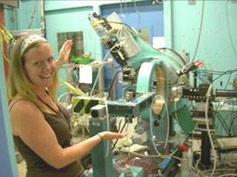
Handy Links
SLAC News Center
SLAC Today
- Subscribe
- Archives: Feb 2006-May 20, 2011
- Archives: May 23, 2011 and later
- Submit Feedback or Story Ideas
- About SLAC Today
SLAC News
Lab News
- Interactions
- Lightsources.org
- ILC NewsLine
- Int'l Science Grid This Week
- Fermilab Today
- Berkeley Lab News
- @brookhaven TODAY
- DOE Pulse
- CERN Courier
- DESY inForm
- US / LHC
SLAC Links
- Emergency
- Safety
- Policy Repository
- Site Entry Form

- Site Maps
- M & O Review
- Computing Status & Calendar
- SLAC Colloquium
- SLACspeak
- SLACspace
- SLAC Logo
- Café Menu
- Flea Market
- Web E-mail
- Marguerite Shuttle
- Discount Commuter Passes
-
Award Reporting Form
- SPIRES
- SciDoc
- Activity Groups
- Library
Stanford
Around the Bay
Preventing Reversals of Fortune
 An international collaborative team of researchers at the Stanford Synchrotron Radiation Laboratory (SSRL) is currently working to learn how to keep uranium soil contamination out of circulation in ground water.
An international collaborative team of researchers at the Stanford Synchrotron Radiation Laboratory (SSRL) is currently working to learn how to keep uranium soil contamination out of circulation in ground water.
Previous experiments show that soil bacteria, with enough fuel, will convert the soluble kind of uranium (hexavalent uranium) into a dramatically less soluble kind (tetravalent uranium).
Now researchers at SSRL want to know how to keep the uranium in that latter state, which should stay put in soils. If it were to revert back to the hexavalent form, which can seep far through the groundwater, the uranium could potentially spread contamination over larger areas. The bacteria chemically reduce hexavalent uranium by giving it extra electrons. But in the presence of oxygen, the uranium oxide could subsequently lose these electrons and be oxidized back to the more soluble form.
John Bargar, head of Molecular Environmental and Interface Science at SSRL, and postdoc Ellie Schofield have been carefully characterizing the molecular-scale of bacteriogenic uranium oxide to understand its structure. Knowing the structure could help in engineering a uranium oxide that is more stable.
The bacteria produce uranium oxide in very small pieces, called nanoparticles. In general, nanoparticles can react differently than their bulkier counterparts. In part this is due to their very high surface areas compared to their volume. Chemical reactions occur more quickly, for example, making researchers wonder whether nanoparticles are more susceptible to being dissolved by groundwater. In addition, the structures of nanoparticles can be strained and distorted (in comparison to their bulkier counterparts), which can significantly destabilize the materials. It is also possible that nanoparticles made by bacteria may be unique as compared to chemically synthesized analogs.
To find out, Bargar and Schofield examined a pure culture of biogenic (bacteria-made) uranium oxide prepared by collaborators at Ecole Polytechnique Federal de Lausanne. Up to half the atoms are on the surface of nanoparticle uranium oxide, potentially creating instability in the entire nanoparticle.
So far, the experiments have found no evidence for significant stress on the nanoparticles, and the structures of the particle interiors are surprisingly pristine. "This is a good thing, it may mean they're less likely to dissolve—that is, that the small particle size may not render them intrinsically unstable," said Bargar.
In the next set of experiments, underway now, the group will repeat measurements on real soil samples from the old rifle site in Colorado where uranium ore had been milled. With added bacteria and oxygen, the scientists want to record the rate at which uranium oxide reoxidizes to the dissolvable kind, all the while looking for factors that might slow this reaction. This work will help to guide our understanding of how molecular- and nano-scale structure controls the behavior of uranium at the field scale.
This research was funded by the DOE-BER ERSD program.
—Heather Rock Woods, SLAC Today, February 13, 2008
Above image: Ellie Schofield with the equipment at Beamline 7-2.